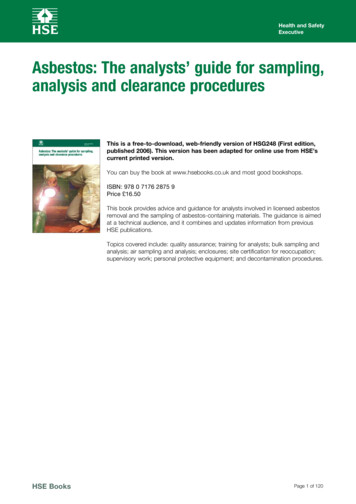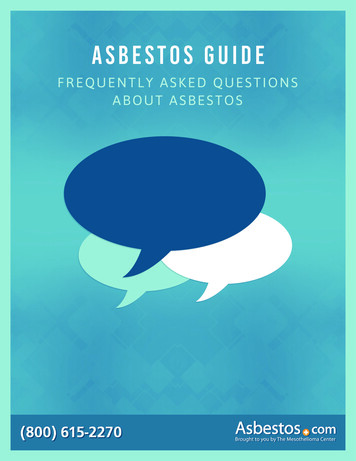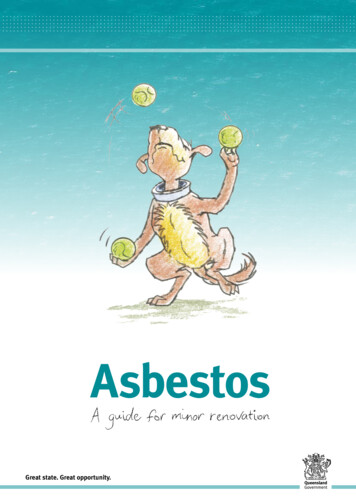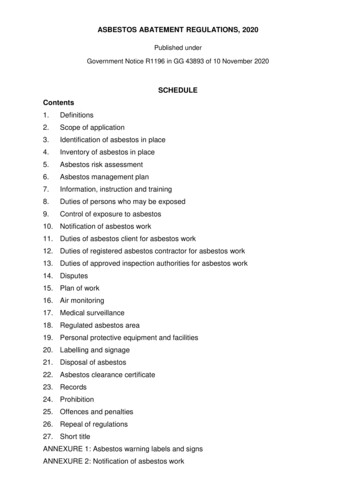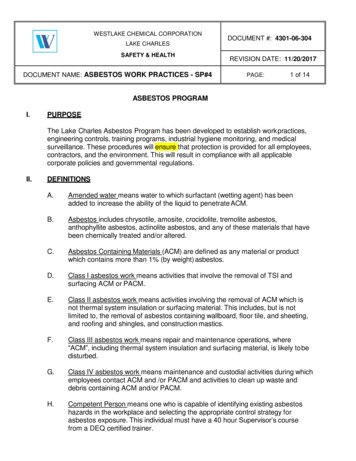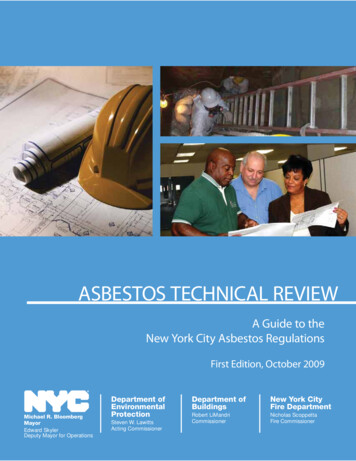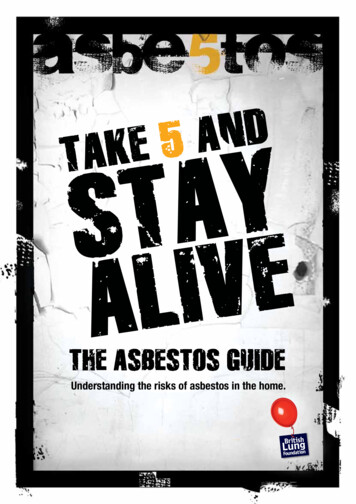
Transcription
THE ASBESTOS GUIDEUnderstanding the risks of asbestos in the home.
TAKE 5 AND STAY ALIVEGet the facts about asbestos before you start your nextDIY project. It could be a life saver.Asbestos first became a popular building material in the 1950s and was used inall sorts of unexpected places until as recently as the late 1990s. Under sinks.Behind tiles. Around pipes. Even in some old paint. Sadly, thousands of peoplein the UK die from asbestos-related diseases every year, and inhaling the dustcan eventually be lethal.So don’t DIY wondering.Before you wade in to your next project, take a few moments to read through thisessential guide. You’ll find lots of important information and useful contacts thatwill help you identify and, if necessary, deal with asbestos in your home.It could be the most important five minutes of your life.CONTENTS1 What is asbestos?2 Where and when was asbestos used?3 What does asbestos look like?4 What if I find asbestos in my home?5 Where can I get all the facts?6 Safety advice7 Health risks8 Case study9 What if I’ve been exposed to asbestos?10 About the British Lung Foundation11 How to donate
1 WHAT IS ASBESTOS?Asbestos is a naturally occurring fibrous mineral that became a popularbuilding material in the 1950s. It is still found in many buildings, includinghospitals, schools and homes.Asbestos was widely used as an insulation and fire proofing solution.In particular, it found its way into products like ceiling tiles, pipe insulation,boilers, sprayed coatings and garage roof tiles.Inhaling loose asbestos fibres is known to cause several serious and even fatallung diseases. So there was no surprise when it was finally banned in 1999.It isn’t uncommon to find asbestos in your home. But happily, in most cases,there’s nothing to worry about. So long as it’s well maintained and not disturbedor disintegrating it does not present any immediate hazard to health.The most important thing is to arm yourself with the facts before you startyour DIY project.Which is why we prepared this guide.
2 Where and when wasasbestos used?Asbestos was widely used in commercial buildings and homes until 1999, when itwas finally banned. So if your house was built after 2000 it should be fine. But anyhome built or refurbished before this date could contain asbestos.If you find asbestos in good condition, the best advice is to leave it alone. It shouldnot be worked on or removed without seeking professional advice.See the diagram on the next page for the most common types and uses foundin the home.
AAsbestos Insulating Board (AIB)BSprayed coatingCTextured decorative coatingsDPipe insulationUsed in ceilings, windows and door panels. Can generate high levels of fibresif cut or drilled. If in good condition, it should be left undisturbed.Found as fire protection on structural supports (eg columns and beams).It is a high hazard asbestos product and can generate very high fibre levels if disturbed.Textured coatings, like Artex, contain a small amount of asbestos.Asbestos thermalpipe lagging isa high hazardasbestos product.HGCAHFIBEEDFloor tilesVinyl (PVC) or thermoplastic tiles contain asbestos.FAsbestos cement roof sheetingGRainwater itemsHWater tanks and toilet cisternsILoose asbestos in ceiling and wall cavitiesOften found on industrial building roofs and walls.Roof gutters and downpipes were often made of asbestos cement.C
3 WHAT DOES ASBESTOSLOOK LIKE?Asbestos comes in all shapes, sizes and colours. The three types are blue, brownand white asbestos, which are found in many building products. But as it wasoften mixed with other materials it can be hard to know if you’ve found it or not.Check it before you wreck it.Remember, even a small amount of asbestos dust is potentially lethal. So don’tstart work if you’re in any doubt.To help you identify asbestos, the Health and Safety Executive has produced auseful image gallery providing real photographs of typical asbestos-containingmaterials that can still be found in buildings today.Take a few moments to visit the gallery before you start on your DIY project.It could be a life saver.hse.gov.uk/asbestos/gallery
4 What if I find asbestosin my home?Don’t panic. Asbestos materials in good condition are not a health risk andshould be fine if you leave them alone. Just check their condition from time to timeto make sure they haven’t been damaged or started to deteriorate.Do not assume tradespeople working in your home know about asbestos andthe risks. If you are the homeowner you have a responsibility to protect anytradesperson from exposure to asbestos fibres.Always tell them if your home contains, or might contain, asbestos, so that theycan plan and price the job correctly. For further information visit the Health andSafety Executive website:hse.gov.uk/asbestos/hiddenkillerWhat if I disturb asbestos?If you have to remove it, it’s essential you seek help from a reputable licensedcontractor as soon as possible, to handle and dispose of it properly.Do not use a domestic vacuum cleaner.Do not put asbestos waste in the dustbin or a skip.Asbestos waste should only be handled by a licensed disposal site. Your localcouncil will have the details. Waste must be transported to these sites in suitablecontainers that prevent the release of asbestos fibres in transit.For more information, contact your local council:direct.gov.uk
5 WHERE CAN I GET ALLTHE FACTS?Stay informed. Stay alive.Thousands of people die in the UK every year from asbestos-related diseases.So the more you know, the safer you and your family will be.To help you identify asbestos in your home and, where necessary, deal with it safely,here’s a list of useful online resources and contacts.You’ll also find an in depth FAQs page on our website:www.blf.org.ukOther resources:Health and Safety Executive hse.gov.uk/asbestos/hiddenkillerNHS Choices nhs.ukDirectgov, to find your local council direct.gov.ukAsbestos Removal Contractors Association arca.org.ukRemember, asbestos removal should only be carried out by a licensed contractor.Contact your local council to get the details of a contractor in your area.
6 SAFETY ADVICEStay safe and stay alive.As with any DIY project, it pays to protect yourself. So always wear overalls,eye protection and a facemask – especially if your job is likely to produce dust.However, asbestos fibres are small enough to penetrate most masks. So neverassume you’re safe.Then there’s the dust that settles on your clothing. This could be a serious healthrisk to everyone you come into contact with. So before you crack on, stop andthink about where you might come across asbestos in your home. It could saveyour life.You’ll find examples of where asbestos was commonly used in section 2 ofthis guide.Don’t take any chances.If you’re in any doubt, check the Health and Safety Executive asbestos gallerybefore you start work:hse.gov.uk/asbestos/galleryWhat DO I DO if I find asbestos?If you do find something suspicious, the good news is that asbestos materialsin good condition are not a health risk so you should leave them well alone.However, you should check their condition from time to time to make sure theyhaven’t been damaged or started to deteriorate.If you find asbestos in poor condition, or accidentally disturb it, do not try to repair orremove the materials yourself. This should only be handled by a licensed contractor– your local council will have the details.For more safety information and advice:Visit the Health and Safety Executive website: hse.gov.uk/asbestos/hiddenkillerContact your local council: direct.gov.uk
7 HEALTH RISKSExposure to asbestos fibres is extremely hazardous and can causeserious and fatal diseases which are responsible for around 4,000 deathsin the UK every year.Since it can take anywhere from 15 to 60 years for the symptoms to develop,asbestos will not affect you immediately – but may do later in life.However, once diagnosed, it’s often too late to do anything.So you need to get the facts to protect you and your family before youstart your DIY project.
MesotheliomaMesothelioma is a type of cancer that affects the ‘mesothelium’ – a thin lining inyour chest and abdomen. Even low levels of exposure to asbestos can cause it andunfortunately the disease is incurable.Asbestos-related lung cancerLike smoking, exposure to asbestos fibres can cause lung cancer. It develops inthe tubes that carry air in and out of the lungs. It can grow within the lung and itcan spread outside the lung. If you smoke and you have been exposed to asbestos,your risk of developing lung cancer is increased compared to the risk associatedwith smoking alone.AsbestosisA serious type of scarring of the lung caused by high levels of exposure toasbestos fibres. This causes the lungs to shrink, resulting in breathlessness.Pleural thickeningA problem linked to heavy asbestos exposure. Scarring of the lining of the lung(pleura) covers a large area and the lining thickens and swells. When this happensthe lung is squeezed, causing breathlessness and discomfort.Pleural plaquesAreas of scar tissue on the lining of the lung (pleura). Usually there are nosymptoms and pleural plaques do not cause any long-term health problems.
DNAE5YATSKATEVIL UDYACASE ST
8AVRIL’S BRUSH WITH ASBESTOS.When Avril Nanton and her husband Des bought anew house in Enfield in the summer of 2007, theyplanned to do some major work on it.“It was quite an old house which was falling to pieces,and we realised everything would have to go, and itmeant we would spend the majority of our money ondoing it up,” says Avril.But one thing Avril, 53, didn’t anticipate was that they might encounter asbestoswhen they were working on the house.“When we were deciding on the work we wanted to be done, one of the builderssaw the ceiling and immediately spotted it as containing asbestos. I would neverhave spotted the asbestos, I expected it to look a bit like the stuff on an ironingboard. We just didn’t know what to look for.”Avril and Des, 41, contacted the council, which visited the house and confirmedthat the substance was asbestos. The council then advised the couple on whatthey could do next.“The man from the council said many houses on the street contained asbestos,and that newer residents in particular had no idea that their houses containedasbestos,” explains Des.In the end the couple decided to have the asbestos taken out, getting a number ofquotes from specialist companies.“We had to have the whole house sealed when it was being done – it looked likesomething out of E.T!” says Avril. “We had it removed at a cost but it meant thatwe could do what we wanted after that without fear. We still have asbestos in ourhouse but as we know about it we are a lot more cautious! A bonus is that now thatwe have had the asbestos removed, we are the only house on the street that has awindow in the roof. ”
9 What if I’ve beenexposed to asbestos?If you’re worried that you might have been exposed to asbestos you can contactthe British Lung Foundation Helpline. The Helpline’s team of specialist nursesand advisers will be able to tell you more about the medical conditions caused byasbestos and, if you think you have been exposed, they’ll advise you on what to donext to check your health.Call the Helpline on03000 030 555Lines are open Monday to Friday, 10am-6pm. Calls are free if you have a call package, or will cost the same as calling a landline, including from mobiles.You might also want to consult your GP and ask for a note to be made in yourpersonal record about possible exposure, including date(s), duration, type ofasbestos and likely exposure levels.In some circumstances, your GP may refer you to a specialist in respiratorymedicine. Asbestos-related damage to the lungs takes years to develop andbecomes visible on chest X-rays. An X-ray cannot indicate whether or not asbestosfibres have been inhaled.There’s lots more information about asbestos-related diseases on the British LungFoundation website:www.blf.org.uk/asbestos
10 About the British LungFoundationLeading the fight against lung disease.The British Lung Foundation is the UK’s lung charity, fighting lung disease throughprevention, support and research.Whether it’s asthma or mesothelioma caused by exposure to asbestos, millions ofpeople in the UK are affected by lung disease. We are here for every one of them,providing hope and support at every step.Find out more about how we can help you:Call the British Lung Foundation Helpline on 03000030 555(Mon-Fri, 10am-6pm)Or visitwww.blf.org.uk
11Make a donation to the British Lung FoundationWe rely on voluntary donations and every penny we receive is vital.Your generosity will make an important contribution to protecting lunghealth and supporting people with lung disease.You can make a donation online atwww.blf.org.uk/giving or call 020 7078 7941(Mon-Fri, 10am-6pm)Thank you.www.take5andstayalive.comOur partners.The British Lung Foundation would like to thank our corporate partners Aviva, Axa,Fentons, Royal and Sun Alliance, Silverdell and Zurich for their continued supporttowards our asbestos programme.This guide was reviewed by independent experts and we have made every effort to ensure that the information providedhere is correct. The British Lung Foundation cannot accept liability for any errors or omissions, and policy, practice ormedical research may change. If you are concerned about your health, you should consult a doctor or for more informationconsult the sources listed. 2012 British Lung Foundation. Registered charity in England and Wales (326730) and in Scotland (SC038415).Registered company limited by guarantee in England and Wales No. 01863614VAT number: 648 8121 18. British Lung Foundation, 73-75 Goswell Road, London, EC1V 7ER
Pipe insulation Asbestos thermal pipe lagging is a high hazard asbestos product. Floor tiles Vinyl (PVC) or thermoplastic tiles contain asbestos. Asbestos cement roof sheeting Often found on industrial building roofs and walls. Rainwater items Roof gutters and downpipes were often made of asbestos cement. Water tanks and toilet cisterns


